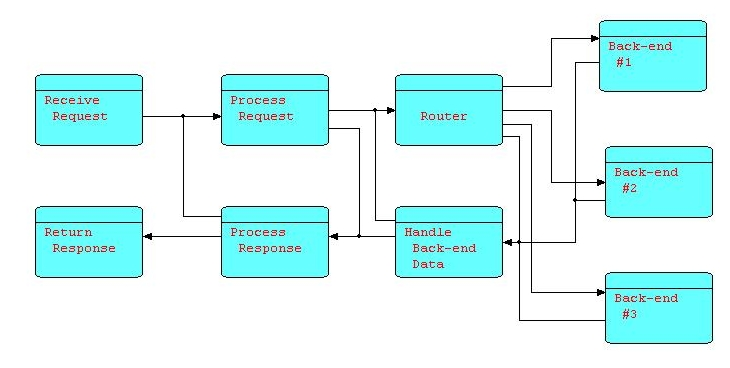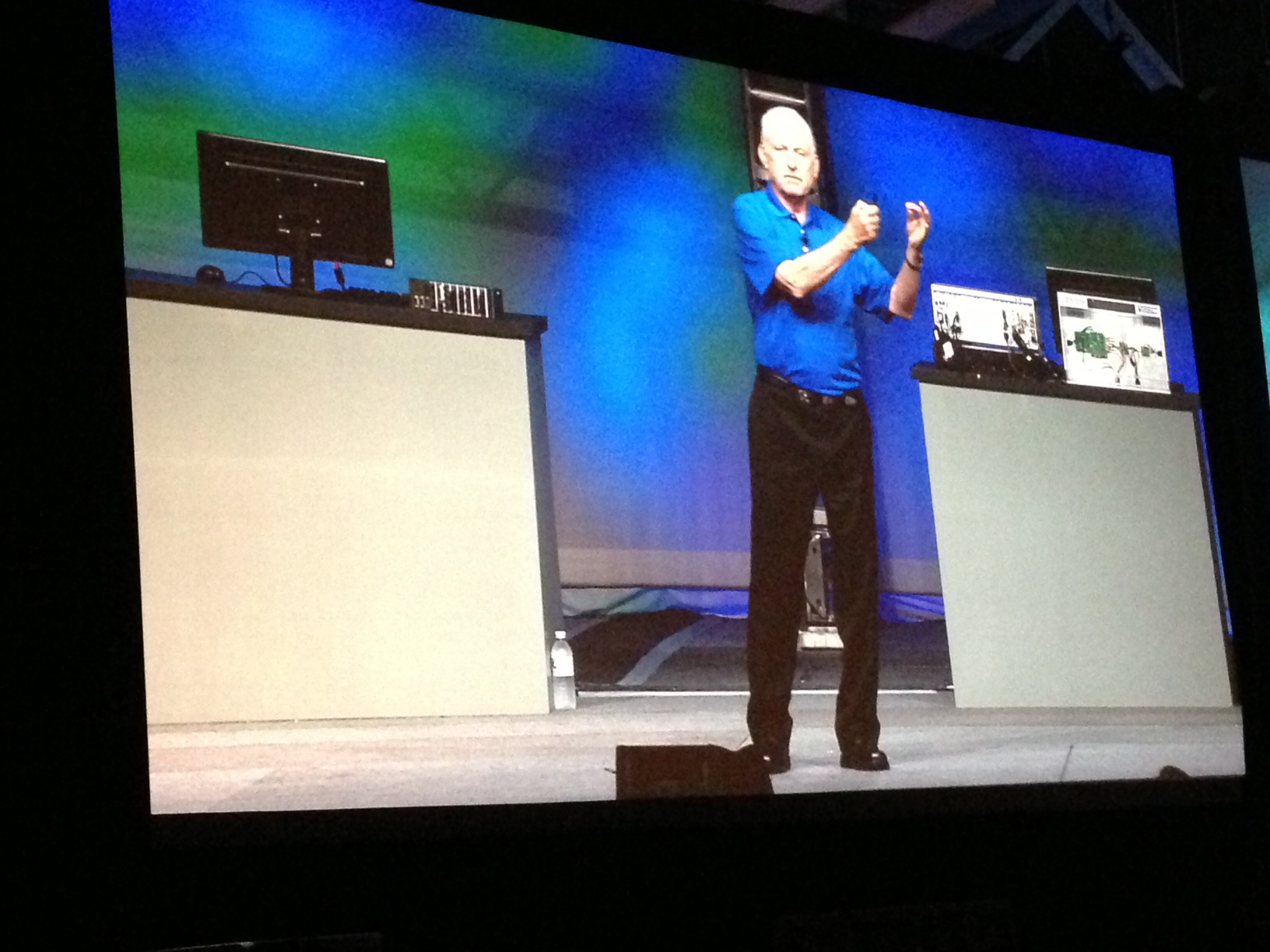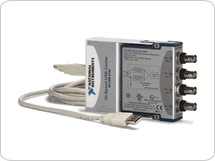
by Gary Mintchell | Aug 16, 2013 | Automation, Technology

Source: Wikipedia
It is interesting, or maybe coincidental, that I had just left the National Instruments user conference about Graphical Programming (among other things) when I downloaded a Robert Scoble podcast interview with the principles of a new company who just launched a flow chart programming tool for high-tech programmers. (I couldn’t find a link for Scoble, but search Scobleizer on iTunes.)
The company has released No Flow JS and many companies had picked it up. A sample of the Flow Diagram Programming accompanies this post.
This brought back all the memories of flow-chart programming from the 90s. The only company still successfully pushing that paradigm to my knowledge is Opto 22. Phoenix Contact picked up the remnants of Think ‘n Do and Steeplechase many years ago. I can remember when the latter two companies thought that everyone would flock to their controllers because it was so much easier and more understandable to program in with flow charts than ladder diagram.
Unfortunately for them, engineers were afraid of the control platform–a PC. I told the CEOs for years that they should stop arguing in their ads about whose real-time operating system was better and concentrate on why engineers should switch from PLCs to the new platform. Meanwhile, Opto 22 found its niche and happily keeps customers happy with its controller and flow-chart programming.
NI uses a paradigm much like function block programming. I have programmed in LabView and recommend it over Ladder. On the other hand, I realize that there remain many thousands of technicians who are quite comfortable in Ladder. But even for those who love Structured Text, perhaps they should take a look at flow chart programming. If it’s coming to mainstream programming, could industrial be far behind?
by Gary Mintchell | Aug 8, 2013 | Automation, News, Organizations, Technology

Dr. James Truchard, NI CEO
The bags are packed and the driver is on the way. I’m leaving Austin and my 16th NI Week–the user conference of National Instruments. Attendance probably was greater than 4,000. Only a few years ago, the number floated around 2,000. This is tremendous growth.
Let’s look at some important factors in NI’s growth.
Stable leadership with vision
James Truchard and Jeff Kodosky founded the company and continue to lead it. They are geniuses (in my humble opinion) in science and engineering. Yet, quite humble gentlemen. They have had a vision of creating a platform and products to help engineers solve ever larger engineering problems that continues to this day.
Not only are they technical gurus, but they also have tremendous organizational skills. They have loved to hire young engineers and turn them loose on problems that stretch their talents. On the other hand, they add a healthy mix of experience and wisdom on the teams to balance the inexperience. Oh, and another important ingredient that has made NI one of the top companies to work for as Truchard told me this week in a conversation is to have fun. Every NI person I’ve met over the past 15 years (with only a few exceptions who self-selected themselves out of the company) has embodied intelligence, creativity and the joy of work.
These concepts extend to the senior leadership team that is also a mix of older / younger members.
There are a few other companies I cover that have had stable leadership. They also are doing well. Maybe not the same audacious vision, but focus all the same. Then I think of the companies I cover with constant turmoil in the executive suite, no real vision, good employees who struggle for meaning. Success for these companies despite having tremendous talent within remains elusive. There is definitely a leadership lesson to be gained.
Putting it all together
Keynotes on Day 2 traditionally feature Kodosky, the father of LabView, expressing some thoughts on computer science and things LabView could be doing. This is followed by featuring people who have accomplished big, hairy, audacious goals using the LabView platform and NI hardware.
Deviating somewhat this year, Kodosky discussed some of the major big science projects (such as CERN) using LabView. He did pitch one thought–the challenges NI (and everyone) face with communication and synchronization. Imagine synchronizing mobile devices on a project. Difficult, but necessary for many problems.
NI Fellow Mike Santori followed with many demos of projects that should spark the creativity of the rest of the audience into accepting new, big engineering challenges.
Day 3 keynotes focus on education. VP Ray Almgren, the Day 3 fixture, brought out a 10-year-old master LabView programmer, a robotic team that developed a robot that could fling frisbees with incredible accuracy, a NASA astronaut who now leads the agency’s education outreach program and the leader of a team that intends to land a robot on the moon in 2015 and explore a deep hole. All featuring LabView and NI hardware based upon its “reconfigurable I/O” or RIO platform. NI has done more to exploit the power of FPGA technology than anyone else I’ve seen.

by Gary Mintchell | Aug 6, 2013 | Automation, Technology
 Dr. James Truchard, president and CEO of National Instruments, kicked off the 2013 edition of the company’s user conference–NI Week. Once again he spoke passionately about the ability of technology to solve complex problems–in industry as well as many other fields.
Dr. James Truchard, president and CEO of National Instruments, kicked off the 2013 edition of the company’s user conference–NI Week. Once again he spoke passionately about the ability of technology to solve complex problems–in industry as well as many other fields.
Recounting the history of instrumentation from vacuum tubes through transistors to software (LabView), he compared iOS apps to virtual instrumentation–going so far as to refer to a bagpipe tuning app on an iPhone.
Turning to a topic I wrote about last April from when I was in Hanover, Germany, he discussed the so-called Fourth Industrial Revolution, or Industrie 4.0 in Germany. The foundation of the new theory is “cyberphysical” systems. Truchard pointed out that he spoke about this topic seven years ago. LabView from its inception has pointed toward cyberphysical systems. “We have the technology to move industry forward,” he stated.
Promoting graphical system design, he noted the advancements of the past few years for doing advanced measurement and advanced control in one system. “We want to do for cyberphysical systems what the PLC did for discrete control,” he proclaimed.
Regarding the vast amount of data now available from all the connected devices, Truchard noted that “more is different” when referring to “Big Analog Data.” The company always had the mantra of acquire, analyse, present. Formerly that referred to one engineer acting locally. Now with the cloud and big analog data that same mantra assumes an entirely different and larger purpose.

by Gary Mintchell | Aug 5, 2013 | Automation, Events, News, Technology
 I just finished listening to the last of an 8-part series of NI Week Promotional Podcasts. Each of the eight featured 2-3 different technology forums or technology symposia plus descriptions of what attendees will see on the exhibit hall floor.
I just finished listening to the last of an 8-part series of NI Week Promotional Podcasts. Each of the eight featured 2-3 different technology forums or technology symposia plus descriptions of what attendees will see on the exhibit hall floor.
A few of the featured speakers talked about their presentations. Lots of cool technology will be presented. Some of the “extras” surrounding the conference were promoted. Figuring National Instruments brings close to 3,000 people to its fair city, it is proud of its environs–and the many interesting activities and variety of food you will find in Austin, Texas.
One of the features today was fitness/wellness. I began attending NI Week in 1998 and ever since enjoy my early morning runs along the banks of Lady Bird Lake (I think I’m right, used to be Town Lake, right?). If you are out there between 5:30 and 6:30 in the morning–a) you can wave to me as I run the path, and b) you can see some of the famous Austin bats returning home after a night of gorging themselves on the plentiful mosquitoes and other insects.
This has always been a fantastic technical conference with many cool technical people and outstanding keynotes. I look forward to my 16th.
If you see me there, stop me and say hi.











